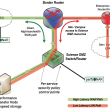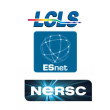Case Studies
A network or service is only as good as how well it addresses the issues and concerns of its users. When our users contact us (infrequently--we are up 99.998 percent of the time) with network issues, it is ESnet's philosophy to help figure out the end-to-end issues and work with our partners to fix problems wherever they occur on a network, so users can experience seamless end-to-end service. Here are a number of examples of how ESnet has resolved many user problems or participated is collaborative efforts where high-speed transfer performance was a requirement.
Our activities also extend beyond immediate problem-solving cases to user education and outreach. We strive to let our users know ESnet's network and services can assist in enabling their science. They don't need to know anything about networking, just know that we exist, and we can help them access, manage and send their data. To this end, we run user requirements workshops for different scientific areas on a regular basis, and are in regular contact with DOE program managers.
We periodically publish case studies to show how different users work with ESnet, and what ESnet can do for our users.
OSCARS Case Studies
OSCARS gives ESnet the ability to engineer, manage and automate the network according to user-specified requirements for using scientific instruments, computation, and collaborations. OSCARS software was initially developed by ESnet under funding by the DOE Office of Science, and is now an open source code. OSCARS has been successfully implemented for many case… Read More
Science DMZ Case Studies
Developed by ESnet engineers, the Science DMZ model addresses common network performance problems encountered at any institution by creating an environment that is tailored to the needs of high performance science applications, including high-volume bulk data transfer, remote experiment control, and data visualization.Since 2009, several science collaborations including those in astrophysics,… Read More
Multi-facility Workflow Case Study
For one experiment at the Linac Coherent Light Source (LCLS) at SLAC National Lab, scientists needed to process their raw data to analyze catalytic reactions. This experiment required over 100 terabytes of data to be processed in semi-real-time so that instruments could be adjusted between 12-hour shifts. To do this, they needed a reliable, high-speed network (ESnet) and a special allocation at… Read More
Multi-layered Network Problems
These case studies provide examples of multi-layered network problems. These are common types of problems, with one issue potentially masking others. The case studies provide insight into how one could go about diagnosing and addressing such… Read More






